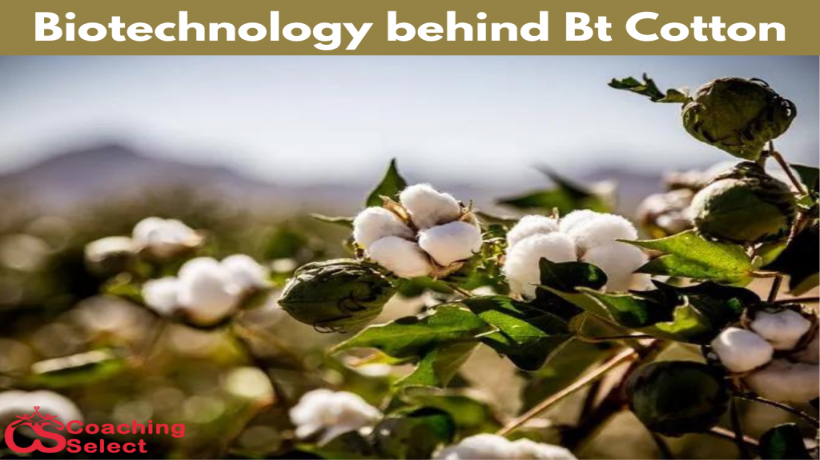Declining Bt Cotton production and Biotechnology failure
In this blog, you will get to know the role of biotechnology in cotton production and its current scenario.
November 24, 2023
Career Expert & Blogger

Introduction
You might recall the excitement that accompanied the introduction of Bt cotton to India. It was hailed as a biotechnology breakthrough that will transform cotton production and solidify India's leadership in the global cotton market. Farmers should expect greater harvests and affluence thanks to the genetic engineering of Bt cotton seeds, which make them resistant to the fatal bollworm insect. More than 90% of Indian cotton growers switched to Bt cotton in a few of years. But in north India, 15 years after its introduction, Bt cotton is failing. Reduced yields, an increase in insect infestations, and decreased earnings are being reported by farmers. Due to the bollworm's resilience, secondary pests are decimating the crop. It's possible that India will lose its status as a cotton powerhouse due to the biotechnology that was meant to preserve the country's cotton crown.
The Rise and Fall of Bt Cotton in India
In 2002, Bt cotton was introduced to India with much enthusiasm. Bt cotton, which was genetically modified to cause the bacterium Bacillus thuringiensis to generate an insecticidal protein, contributed to India becoming a major exporter of cotton. However, particularly in northern India, the production and quality of Bt cotton have drastically decreased recently.
At initially, farmers eagerly embraced Bt cotton, and between 2002 and 2015, the acreage increased by more than ten times. The original Bt cotton hybrids increased yields and decreased the need for pesticide treatments since they were very efficient against bollworms, the main pest of cotton. However, secondary pests like mealybugs and whiteflies became dangerous as the bollworms quickly became resistant to the Bt poisons.
Farmers have suffered financial losses as a result of Bt cotton's subpar performance. In certain regions of Punjab, Haryana, and Rajasthan, the yields of Bt cotton have decreased by more than 50%. Farmers' revenues have decreased due to reduced market prices brought about by the poor quality of Bt cotton. To reduce losses, a lot of farmers have switched back to traditional cotton cultivars.
It has been impossible for biotechnology companies to create Bt cotton hybrids that are suitable for India's varied agroclimatic conditions. They failed to test novel hybrids locally before to commercialization because they underestimated the speed at which the target pests would become resistant. Public researchers have found it challenging to create superior cotton cultivars for Indian settings because to strict laws around genetically modified organisms.
The emergence and decline of Bt cotton in India highlights the significance of sustainable biotechnology solutions that are tailored to local conditions. With the support of integrated pest control strategies and newly developed Bt cotton hybrids suited to local conditions, India might be able to take back its top spot in the world cotton output rankings.
The Biotechnology Breakdown: Bt Cotton Fails to Deliver
India's cotton growers were promised increased crop yields and financial success with the introduction of Bt cotton. But biotechnology hasn't been able to produce long-term gains, which has caused a collapse that puts India's cotton dominance in jeopardy.
The Flawed Foundation of Bt Cotton
Bacillus thuringiensis (Bt) is a bacterium that was designed into Bt cotton in order to increase the plant's resistance to several insects, particularly the cotton bollworm. In 2002, genetically modified cotton was brought to India and marketed as a remedy for declining agricultural productivity and rising expenses. The effectiveness of the device, meanwhile, was predicated on the false belief that the insects it was intended to kill would not become resistant.
The Devastating Impact on Cotton Farmers
For cotton growers in North India, Bt cotton's failure has proved disastrous. Bt cotton was created as the only genetically modified crop authorised for commercial production in India with the goal of eliminating the bollworm threat and increasing yields. But poor local adaptation and weak insect resistance have led to a sharp decline in Bt cotton output, driving many farmers into debt and desperate situations.
- Ineffective Pest Resistance
The purpose of the toxin Cry1Ac, which is produced by Bt cotton, is to destroy the American bollworm. But in many regions of India, the bollworm has grown resistant to Cry1Ac after ten years of cultivation. Once offering 95% protection against bollworm, bt cotton now only gives 50–60% protection. Reduced yields have also resulted from the introduction of secondary pests such mealybugs, aphids, and whiteflies that are not impacted by Bt.
- Poor Adjustment to Local Conditions
Hybrids of Bt cotton were not created with India's varied agroclimatic conditions in mind. To get optimal yields, they necessitate significant inputs like fertilisers and irrigation, which the majority of Indian farmers are unable to supply. Additionally, because of its limited genetic foundation, Bt cotton is more vulnerable to environmental challenges including salt and drought.
Future: Can India Regain Its Cotton Crown?
India used to be the world's biggest producer of cotton, but falling yields and quality have caused it to lose a considerable portion of the worldwide market in recent years. India has to solve the technological and policy shortcomings that caused this decrease in order to revitalise its cotton sector.
- Improve Bt cotton strains
Early in the new millennium, India quickly embraced Bt cotton, which resulted in significant output improvements for several years. Nevertheless, the misuse of one strain of Bt cotton (Bollgard II) has decreased its efficacy by allowing pests to become resistant. To stop pest resistance, India should promote the creation of new Bt cotton hybrids with several insect-resistant features. In order to satisfy market demand, it should also implement more recent biotech cotton cultivars with better fibre quality.
- Reform restrictive policies
The introduction of better cotton types has been hindered by India's stringent rules regarding genetically modified (GM) crops. The government ought to devise a coherent, scientifically grounded regulatory framework to expeditiously approve novel genetically modified cotton cultivars. Additionally, it must to provide private enterprises more latitude in creating and promoting novel cotton hybrids in order to foster innovation.
- Invest in research
India has seen a decrease in public and commercial financing for cotton research and development, despite an increase in spending from other key producers. To raise yields, increase fibre quality, and develop cutting-edge breeding procedures to the levels required in international markets, more funding is required. Increasing research investment will be beneficial for India's recovery of its cotton leadership, particularly for public institutions.
Conclusion
For India's cotton farmers, the introduction of Bt cotton eventually proved devastating, despite its first seeming promise. India has lost its position as the world's top producer of cotton because to an excessive dependence on one biotechnology and a disregard for the long-term effects. As you've seen, in order to correct the mistakes of the past, the situation calls for immediate action and a renewed dedication to science-based policies. But the future is still open, and if the right actions are done, India may still win back the world's cotton crown. It is up to stakeholders and legislators to enact the modifications required to assist cotton growers, foster variety, and advance sustainability.



